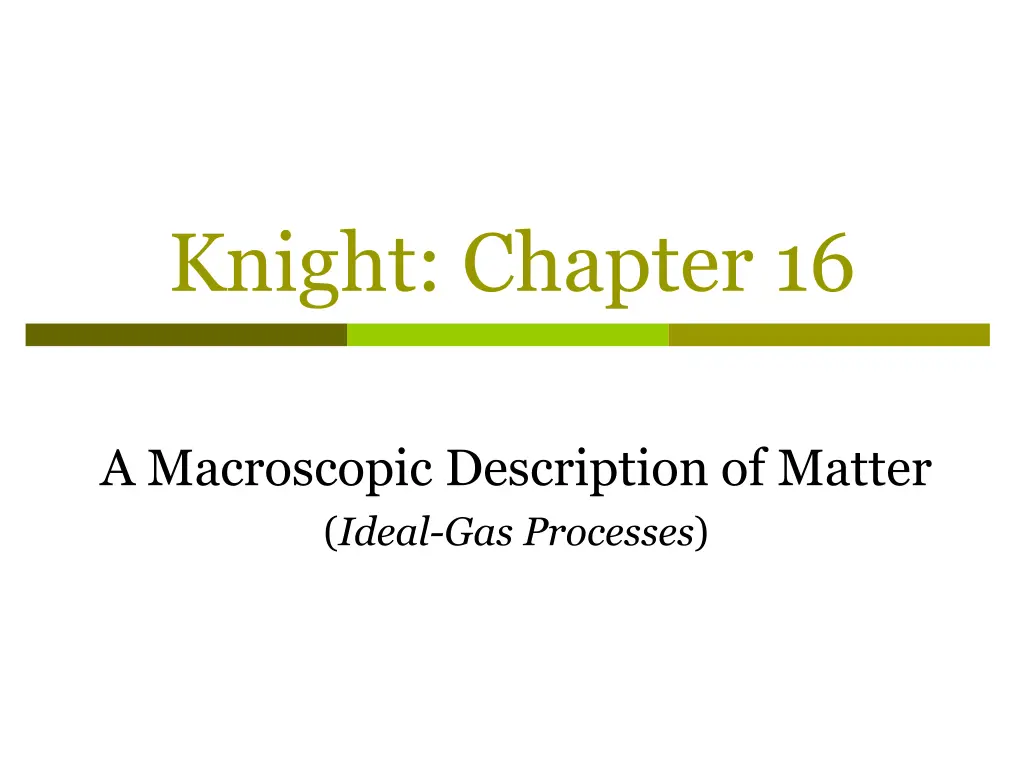
Macroscopic Description of Matter in Ideal-Gas Processes
Explore the macroscopic description of matter in ideal-gas processes through concepts like constant-volume and constant-pressure processes. Ideal for understanding gas behavior in sealed containers and the relationship between temperature, pressure, and volume. Quiz questions included.
Download Presentation

Please find below an Image/Link to download the presentation.
The content on the website is provided AS IS for your information and personal use only. It may not be sold, licensed, or shared on other websites without obtaining consent from the author. If you encounter any issues during the download, it is possible that the publisher has removed the file from their server.
You are allowed to download the files provided on this website for personal or commercial use, subject to the condition that they are used lawfully. All files are the property of their respective owners.
The content on the website is provided AS IS for your information and personal use only. It may not be sold, licensed, or shared on other websites without obtaining consent from the author.
E N D
Presentation Transcript
Knight: Chapter 16 A Macroscopic Description of Matter (Ideal-Gas Processes)
Quiz Question 1 The temperature of a rigid (constant-volume), sealed container of gas increases from 100 C to 200 C. The gas pressure increases by a factor of 2. 1. 1.3. 2. 1 (the pressure doesn t change). 3. 0.8. 4. 0.5. 5.
Ideal-Gas Processes can be represented on a graph of pressure vs volume (a.k.a. pV diagram) knowing p & V for a given n, we can find the temp T using the ideal-gas law. ly many ways to change gas from state 1 to state 3. Here are two different trajectories on the pV diagram.
Ideal-Gas Processes Quasi-static process: process that is essentially in thermal equilibrium at all times. (a) If you slowly pull a piston out, you can reverse the process by slowly pushing the piston in. (b) is NOT quasi-static & cannot be represented on a pV diagram. Notice: This textbook will always assume that processes are quasi-static.
Constant-Volume Process a.k.a. isochoric process the gas is in a closed, rigid container. Warming the gas with a flame will raise its pressure w/out changing its volume. Vertical line on pV diagram
Constant-Pressure Process a.k.a. isobaric process The pressure of the gas is:
Constant-Pressure Process a.k.a. isobaric process The pressure of the gas is: The pressure is independent of the temperature of the gas or the height of the piston, so it stays constant as long as M is unchanged.
Constant-Pressure Process a.k.a. isobaric process Warming the gas with a flame will raise its volume w/out changing its pressure. Horizontal line on pV diagram
Quiz Question 2 A cylinder of gas has a frictionless but tightly sealed piston of mass M. The gas temperature is increased from an initial 27 C to a final 127 C. What is the final-to-initial volume ratio Vf/Vi? 1.50 1.33 1.25 1.00 Not enough information to tell. 1. 2. 3. 4. 5.
Constant-Temperature Process a.k.a. isothermal process Consider a piston being pushed down to compress a gas Heat is transferred through the walls of the cylinder to keep T fixed, so that:
Constant-Temperature Process a.k.a. isothermal process Consider a piston being pushed down to compress a gas Heat is transferred through the walls of the cylinder to keep T fixed, so that: The graph of p vs V for an isotherm is a hyperbola.
Quiz Question 3 A gas follows the process shown. What is the final-to-initial temperature ratio Tf/Ti? 2 1. 4 2. 8 3. 16 4. Not enough information to tell. 5.
i.e.16.9: Compressing air in the lungs An ocean snorkeler takes a deep breath at the surface, filling his lungs with 4.0L of air. He then descends to a depth of 5.0m. At this depth, what is the volume of air in the snorkeler s lungs?
i.e.16.10: A multi-step process A gas at 2.0 atm pressure and a temperature of 200 C is first expanded isothermally until its volume has doubled. It then undergoes an isobaric compression until it returns to its original volume. First show this process on a pV diagram. Then find the final temperature and pressure.
i.e.16.10: A multi-step process A gas at 2.0 atm pressure and a temperature of 200 C is first expanded isothermally until its volume has doubled. It then undergoes an isobaric compression until it returns to its original volume. First show this process on a pV diagram. Then find the final temperature and pressure.
